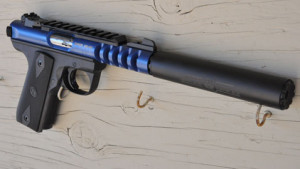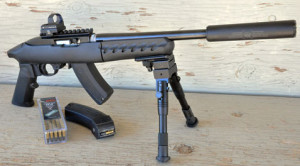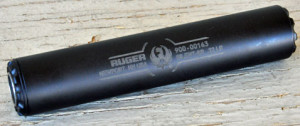
Whether you call them suppressors, silencers, mufflers or cans, these shooting accessories are here to stay.
You can review the specification on the Silent-SR on Ruger’s website but here are the basics: With a ½” – 28 thread the Silent-SR is made to screw onto barrels in the .22 LR class. The Silent-SR is stoutly constructed and is made of titanium, stainless steel and aluminum so it can also be used with .22 Magnum and .17 HMR calibers as well as .22LR. It’s a little under five and a half inches long and weighs 6.3 ounces, meaning it’s about the same size and a tad heavier than some of the all-aluminum suppressors in this class but, presumably, stronger and longer lasting. As with Ruger’s firearms, the Silent-SR is all-American made and is produced in Ruger’s Newport, New Hampshire factory.
Silencing any firearm is a function of several factors, to include barrel length, ammunition and the efficiency of the silencer. Do silencers render firearms silent? No, they reduce the noise signature significantly but the quietest ones in my experience are those attached to rifles firing .22 LR sub-sonic ammunition. To keep things simple let’s just call any ammunition that leaves the muzzle at less than 1,000 feet per second (fps) sub-sonic. This means the bullet doesn’t achieve the speed of sound and there is no supersonic “crack”. Can you shoot supersonic ammunition with a silencer? Sure, it will be quieter than shooting without a silencer but there will be more noise due to that supersonic crack. When we’re talking about .22 LR ammunition 
For the ultimate in .22 LR silenced shooting, try attaching a good silencer to a .22 rifle. When testing the Silent-SR I had an opportunity to shoot it with Ruger’s new bull barreled 10-22 Takedown and I have to tell you the noise from the bolt clicking back and forth was pretty much all I could hear. If you want to eliminate even that sound, attaching the silencer to a bolt-action rifle firing sub-sonic ammunition produces the closest thing to silent shooting I have experienced.
Ruger has a corporate policy of spurring growth in the company with new products and the Silent-SR certainly qualifies as a new product. I think you can expect this .22 caliber silencer to be the first in a new product line, and, if I had to guess, and it’s purely a guess, I would expect to see a 5.56 or 7.62 caliber silencer come out next. With a suggested retail price of $449.00 I predict the .22 caliber Silent-SR is going to sell like the proverbial hotcakes.
About the Author:
Ed Head is a regular on Shooting Gallery, Gun Stories and Down Range TV. He has worked for almost 30 years in law enforcement, first in the United States Air Force and then with the United States Border Patrol, retiring as a Field Operations Supervisor. During his Border Patrol career, Ed worked in a variety of patrol, investigative and training capacities. Ed has an extensive background as a firearms instructor, having trained thousands, ranging from beginners to police, military and special operations personnel. Having taught at Gunsite for 20 years, Ed first trained there under the world famous shooting school's founder, Jeff Cooper, then later ran the school as the operations manager for more than five years. Ed lives in Chino Valley, Arizona, where he continues to teach and write.

Walang komento:
Mag-post ng isang Komento